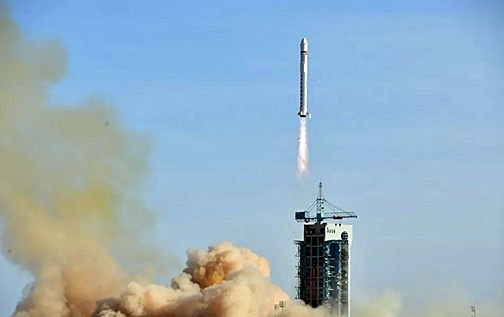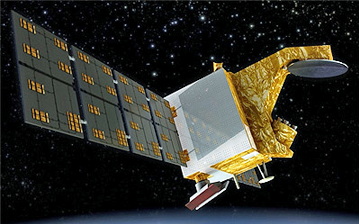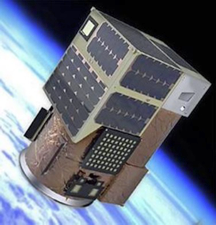
China's launch of the Zhangheng-1 satellite and secondary payloads.
On February 2, China launched the nation's first seismo-electromagnetic satellite to study seismic precursors, which could help establish a ground-space earthquake monitoring and forecasting network.
The satellite, Zhangheng-1, will help prepare the research and technologies for a ground-space earthquake monitoring and forecasting system in the future.

Artistic rendition of China's Zhangheng-1 satellite.
The launch occurred at 15:51 from the Jiuquan Satellite Launch Center in northwest China's Gobi Desert and carried the 730 kg. China Seismo-Electromagnetic Satellite (CSES) into a Sun-Synchronous Orbit (SSO) at an altitude of about 500 km. and has an expected mission life of five years, according to Zhao Jian, a senior official with China National Space Administration (CNSA).
The launch vehicle was a Long March 2-D rocket developed by the Shanghai Academy of Spaceflight Technology, designed mainly for LEO satellite launches.
The satellite is named after Zhang Heng, a renowned scholar of the East Han Dynasty (25-220) who pioneered earthquake studies by inventing the first ever seismoscope in the year 132. Zhangheng-1 will record electromagnetic data associated with earthquakes above level six magnitude in China and those above seven magnitude around the world in a bid to identify patterns in the electromagnetic disturbances in the near-Earth environment, Zhao said.
Covering the latitude area between 65 degrees north and 65 degrees south, the satellite will focus on the Chinese mainland — areas within 1,000 km. to China's land borders and two major global earthquake belts. Zhangheng-1 was funded by CNSA, developed by China Earthquake Administration (CEA) and produced by DFH Satellite Co., Ltd., a subsidiary of China Academy of Space Technology (CAST).
Based on a CAST2000 platform, Zhangheng-1 is a cubesat that measures 1.4 meters on each side. The satellite has a single solar panel and six booms, which will deploy and keep electromagnetic detectors more than four meters away from the satellite, said Zhou Feng, a senior manager with DFH Satellite Company.
The satellite carries a high-precision magnetometer, a search-coil magnetometer and electric field probes to measure components and intensity of the magnetic and electric fields and is also equipped with a Langmuir probe, a plasma analyzer, a GNSS occultation receiver and a tri-band beacon to measure in-situ plasma and ionospheric profiles as well, added Zhou. Also aboard are high-energy particle detectors, some of which were provided by Italian partners as well as a magnetic field calibration device developed in Austria, according to Zhou.
Zhangheng 1 will help scientists better understand the mechanisms of the upper atmosphere, ionosphere and magnetosphere and the temporal variations of the geomagnetic field, and thus accumulate data for the research of seismic precursors, Zhao said, adding that Zhangheng 1 cannot be used to predict earthquakes directly, but it will help prepare the research and technologies for a ground-space earthquake monitoring and forecasting system in the future.
In addition to the primary Zhangheng-1 payload were six smallsats...

Artistic rendition of the
Aleph-1 4 smallsat.
The Aleph-1 4 and Aleph-1 5 smallsats, manufactured and operated by Satellogic S.A., were part of this lift and are members of Argentina's planned Aleph-1 constellation, whose smallsats will engage in the commercial opportunities provided by Earth Observation (EO) imagery to consumers.
Also included in this launch were the GOMX-4A and GOMX-4B smallsats from GomSpace. They will orbit 4,500 km. apart to test comms linkage between the two spacecraft and a ground station as well as propulsion technologies for smaller satellites. (See satnews.com/story.php?number=2043797726).
A 3U cubesat is a participant from Link Space Aerospace Technology that will demo technology and scientific education.

Artistic rendition of China's
Shaonian Xing smallsat.
Another smallsat in this launch was developed by Chinese students — the Shaonian Xing — with the purpose of promoting STEAM (science, technology, engineering, art and mathematics) education.

